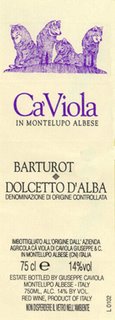 It's Halloween and the ghosties and ghoulies will be out soon, so I came home early to make some soup to slurp between the rings at the doorbell and to bring some warmth to what it turning out to be a rather chilly and grey day. Perfect for trick-or-treaters, less so for the rest of us.
It's Halloween and the ghosties and ghoulies will be out soon, so I came home early to make some soup to slurp between the rings at the doorbell and to bring some warmth to what it turning out to be a rather chilly and grey day. Perfect for trick-or-treaters, less so for the rest of us.I thought the wine to go with my hearty Nigella Lawson minestrone might be this 2003 Ca'Viola Dolcetto D'Alba Barturot ($24.69, Costco). This is slightly above my normal price cut-off, but I do love dolcetto, which translates roughly from the Italian as "little sweet one." A grown-up treat then, or so I tell myself, and far better for me than diving into the bowl of candy set aside for the ghosties and ghoulies.
The Columbia Wine Guy over on Brim to the Dregs is working his way alphabetically through wine (great idea!) and he hit "D" just the other day and gave some great information on dolcetto, as well as a more budget-friendly recommendation than mine is tonight.
My minestrone recipe comes from Nigella Lawson's How to Eat (recipe not online). I should note here that this is not a tomato-based minestrone, but instead a pale, golden version with lots of vegetables and a special, not-to-be-omitted ingredient: a parmesan cheese rind. I tried to take a picture of my soup in the kettle (clearly a lot to be learned about this), to show both the color and (in the upper left) the rind bobbing around in the soup.
 The parmesan rind gives it a little kick of salinity, and a richness of flavor that is indefinable, but distinctive. On Ms. Lawson's advice, no parmesan rinds are thrown out in my house: they are all bagged up popped into the freezer to stick in soups, stews, and pasta sauces. (PS: You discard the rind before you serve the soup. It gets gummy. You are forewarned.)
The parmesan rind gives it a little kick of salinity, and a richness of flavor that is indefinable, but distinctive. On Ms. Lawson's advice, no parmesan rinds are thrown out in my house: they are all bagged up popped into the freezer to stick in soups, stews, and pasta sauces. (PS: You discard the rind before you serve the soup. It gets gummy. You are forewarned.)On to the 2003 Ca'Viola Dolcetto d'Alba Barturot. Ca'Viola is in the Piedmonte region of Italy, and the oenologist, Giuseppe Caviola, has been dubbed the "King of Dolcetto" and received the 2002 Gambero Rosso Winemaker of the Year. This wine was made of 100% dolcetto d'alba grapes aged in stainless steel for 10-12 months. For those who have not tasted a red wine that has not had any oak aging, this is your chance.
The first impression you get of this wine is purple--the color of dark aubergines. Once you pick it up and take a good look at it you see it is really a true ruby red with lovely bluish tones to it. I found this wine needed a fair bit of time to settle down and open up. When it was first opened and poured it smelled very alcoholic (14.5% alch./vol.). Even after it's been in the glass a while the aromas are spicy rather than fruity. This is confirmed on the palate, which is predominantly spicy with an undertone of red fruit. Lots of acidity and a tinge of minerality at the end of each sip. It was much better with the food than as a stand alone wine.
I felt this wine needed a bit more fruit to balance out all those intriguing spice and mineral flavors, and that for the price this represented good QPR. If you are looking for a low-tannin, high-acid red with little oak influence that would go well with pasta with red sauces, it is for sale at many merchants throughout the US, and typically retails for under $30.
4 comments:
Thanks for the mention. I was pleased to see Eric Asimov writing about dolcetto in The NY Times also. Great minds must really think alike.
Columbia Wine Guy: Thanks to you, for a great article that inspired me to take that bottle out of the rack. And it's clear that we are on the same wave as Asimov--I picked up my IWA catalogue and had the same reaction to the Clef du Vin as he did and thought "I have to write about this!" Now he's scooped me!
Regarding your minestrone, FYI,
that "undefinable richness" you're getting from the cheese rind is known as "umami," or the taste of the amino acid glutmate. Parmesean cheese contains about 1% free glutamate.
Thanks, Carmine! I knew umami was in soy sauce, but not in parmesan cheese. Here it really makes a difference, and much in the way that an aged soy does with sushi.
Post a Comment